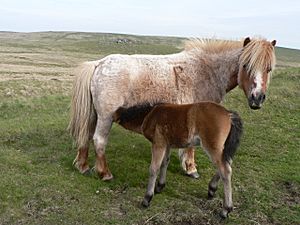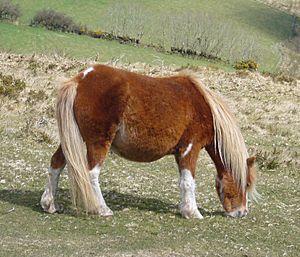Dartmoor pony facts for kids
| Distinguishing features | Small but strong, many colours, hardy |
|---|---|
| Country of origin | England |
| Horse (Equus ferus caballus) | |
The Dartmoor Pony is a special breed of pony that lives in Dartmoor, England. These ponies have been in England for hundreds of years and are used for many different things. They are very tough and have great energy. This is because they live in Dartmoor, where the weather can be very extreme. For a long time, people used them as working animals, like carrying heavy loads from tin mines and quarries. Today, many still live in a semi-wild state on Dartmoor.
Sadly, the number of Dartmoor Ponies living freely on the moor has gone down a lot. In 1900, there were about 5,000. Now, only about 300 are officially registered. In 2004, only about 800 ponies were seen grazing on the moor.
Contents
What Makes a Dartmoor Pony Special?
Looks and Features
The Dartmoor Pony has a small head with big, wide-set eyes and ears that stand up straight. Their body is strong, with a wide chest and a medium length. Their legs are strong, with good bones. Their front legs connect to shoulders that are well-angled, allowing them to move freely. Their back legs are muscular and rounded.
A Dartmoor Pony's mane and tail should be full and flowing. They move freely and smoothly. These ponies are known for being kind, gentle, and calm. Most Dartmoor Ponies are between 11.1 and 12.2 hands tall. According to the breed rules from 1924, a pony should not be taller than 13 hands.
Colors and Markings
You can find Dartmoor Ponies in many colors, including bay (brown body with black mane and tail), brown, black, grey, chestnut (reddish-brown), or roan (a mix of white and colored hairs).
However, Dartmoor Ponies cannot have piebald (large black and white patches) or skewbald (large brown and white patches) coloring. If you see ponies with these colors on Dartmoor, they are likely "Dartmoor Hill Ponies." These are ponies born on Dartmoor but are not purebred Dartmoor Ponies. Local farmers can let any type of pony graze on the moors. The Dartmoor Hill Pony is not a true breed because only ponies born on the moors can be registered as such.
Even though Exmoor Ponies live nearby and look a bit similar, new information suggests that Dartmoor and Exmoor Ponies are not related.
A Look Back: History of the Dartmoor Pony
Ancient Beginnings
Bones of ancient horses have been found in old burial sites in southern Britain, dating back to around 3500 BC. These were likely wild horses, but people might have started taming them around that time. Studies from the 1970s show that tamed ponies were living on Dartmoor as early as 1500 BC.
The first written record about wild horses in the Ashburton area dates back to AD 1012. Early records from Dartmoor also mention ponies being branded and earmarked (marked on their ears) by their owners.
Working Ponies
In the Middle Ages, Dartmoor Ponies were very important. They carried heavy loads of tin from the mines across the moor. When the mines closed, some ponies stayed on farms, but most were set free onto the moor.
From the early 1900s to the 1960s, ponies were even bred at Dartmoor Prison. Guards used them to escort prisoners.
Adding New Blood
Over time, other horse breeds were introduced to the Dartmoor Pony. For example, Arabian horse blood was added from a stallion named Dwarka, born in 1922, and his son, The Leat. Welsh Pony blood came from a stallion named Dinarth Spark. Some Fell Pony blood was also added.
Saving the Breed
The first time people tried to officially define and register the Dartmoor Pony was in 1898. They were listed in a studbook (a record of breeding animals) started by the Polo Pony Society. In 1924, the official breed society was formed, and its own studbook was opened.
However, World War I and World War II were very hard on the breed. Not many ponies were registered during World War II. After the war, local people worked hard to find and register as many ponies as they could. By the 1950s, their numbers had increased again.
To help stop the decline and make the breed stronger, two special plans were started. The Dartmoor Pony Moorland Scheme began in 1988. In 2004, a new plan called the Dartmoor Pony Preservation Scheme was introduced. The Dartmoor Pony is now considered a "Rare Breed," meaning it needs protection.
Dartmoor Ponies Today
Dartmoor Ponies are native to Britain, but you can also find them in other parts of the world, like the USA, Europe, New Zealand, and Australia. They are often used to start new breeds, like the Riding Pony.
These ponies are a good size and have a calm personality, making them perfect for children to ride. But they are also strong enough to carry adults! They are used for many activities, such as hunting, trail riding, showing, jumping, dressage, and driving carriages. They are also great for everyday riding.
All the ponies living freely on Dartmoor are owned and protected by local farmers called Dartmoor Commoners. It is against the law for visitors to feed the ponies.
Sources
Images for kids




